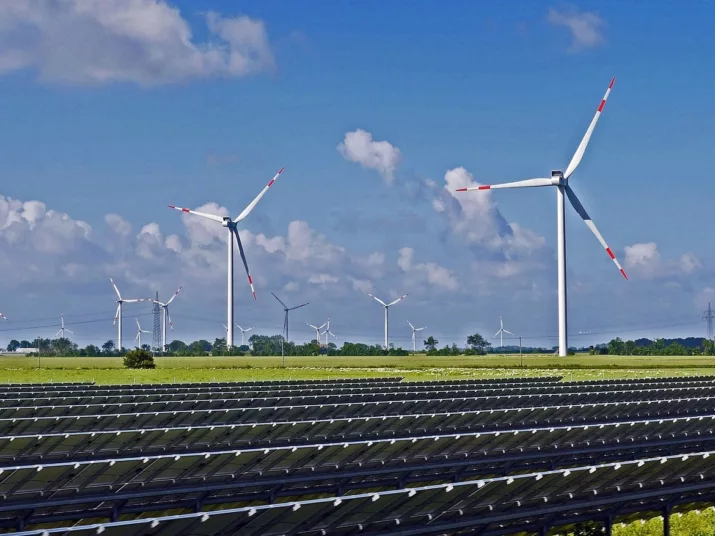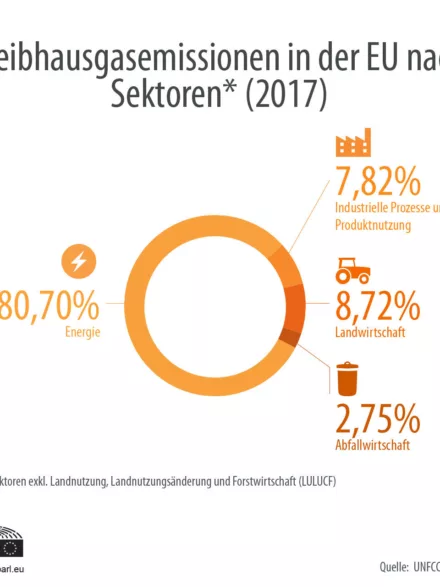
How to Stay Charged in the Future
Smart and Clean
How can we stop climate change? Only by using the power of the sun and the wind and other renewable energy sources, say the experts. And with new energy concepts.

For our climate, it’s five minutes to midnight. And humankind is to blame. Or more precisely: the huge amounts of the greenhouse gas CO2 that we produce. A particularly large amount of this greenhouse gas is formed when fossil fuels such as fossil oil or natural gas are burned: more than 90 percent of human-induced carbon dioxide is caused by the generation of electricity, heat and fuel. [1] This makes the global hunger for energy the number one climate killer.
Energy consumption and sources on trial
In order to meet international climate protection targets, CO2emissions must fall to zero in all countries before the end of the 21st century. Energy consumption, as one of the main causes of climate change, is therefore under scrutiny around the globe: the amount of energy that is to be consumed in the future, and the sources used to generate electricity, heat and fuels, have thus become key questions in the field of climate protection.
According to the European Environment Agency (EEA), the energy sector accounts for 80 per cent of the greenhouse gases produced in the EU.

The goal of the global energy transition is clear: in the future, fossil energy sources must no longer play a role. Today, however, they still call the shots. According to the BP Statistical Review of World Energy 2016, 85 per cent of the energy consumed worldwide comes from fossil sources. At 10 per cent, renewable energies such as wind, water or sun play a subordinate role, as does nuclear power (4 per cent).
Renewables on the path to success
While safety concerns have turned nuclear power plants into a source of controversy worldwide – and because their extremely high safety and disposal costs rule them out as economically feasible – experts are united on one point: renewable energies are the future. Their carbon footprint is unbeatable: when sun, wind, water or biomass are converted into electricity, heat or fuel, no air pollutants are produced. Moreover, unlike fossil resources, green energy sources are available in abundance. Renewable energy sources alone are sufficient to supply the entire world with energy.
Click on the square below the graphic to enlarge it:
According to the Renewable Energies Agency (Agentur für Erneuerbare Energien e. V. – AEE), solar energy alone would suffice to meet the world’s energy needs 2,850 times over. [2] A study by the Mercator Research Institute on Global Commons and Climate Change (MCC) has found that photovoltaics could probably satisfy between 30 and 50 per cent of the global energy needs as early as 2050. [3] New technologies such as solar facades or huge solar power plants, which promise great electricity yields, especially in desert regions, are driving this development on.
The wind energy sector is growing rapidly too. While the total output of new wind-energy installations around the world amounted to 38.6 gigawatts in 2009 – a record value back then – this figure rose to 63 gigawatts by 2015, according to the German Wind Energy Association. [4]. Since 2010, the majority of new power stations have been erected outside OECD countries. Novel concepts such as airborne wind turbines, intended to enable the use of wind energy around the globe, are currently being promoted.
More money for clean energies
What’s boosting the industry worldwide: the cost of wind turbines and solar modules has dropped dramatically thanks to new technologies. This is also reflected in electricity prices. While fossil fuels such as fossil oil or coal are becoming more and more expensive, renewable energies are becoming cheaper and cheaper. According to a report by the International Renewable Energy Agency (IRENA), by 2020 all renewable energies should be able to match, or even undercut, the electricity prices of conventional energies. [5]
International investment figures show that natural energy sources are highly likely to pay off in the future – for the climate, for consumers and for companies. They have been increasing for years and are creating optimal conditions for the energy turnaround. The International Energy Agency’s (IEA) World Energy Investment Report 2019 shows: total financial investments in the energy sector amounted to USD 1.85 trillion (EUR 1.69 trillion), while investments in the renewable energy sector amounted to more than USD 300 billion (EUR 274 billion). [6] The IEA analysts state: since 2010, investments in renewable energies have thus risen by 55 per cent, if the falling prices for solar, wind and the like are taken into account.
Another finding of the World Energy Investment Report 2019 that is not just inspiring for climate activists alone: since 2004, there has never been such little investment worldwide in coal-fired power generation. China, the US and Europe, in particular, are investing in renewable energy, according to the study by UN Environment’s Economy Division, the Frankfurt School – UNEP Collaborating Centre for Climate & Sustainable Energy Finance, and Bloomberg New Energy Finance (2018). But the experts emphasise that further investments must follow: they predict that global energy demand will increase steadily over the next few decades – by at least a quarter by 2050, according to the IEA.
New rules for the electricity market
The chances of a successful switch to an energy system based on renewables are good – thanks also to new market regulations. To take Europe as an example: the second part of the “Clean Energy for All Europeans” legislative package, which was adopted by the European Parliament in March 2019, provides a powerful push towards the energy transition.
The EU-wide objective stipulated by the policy is to make EU electricity markets more flexible in the future and enable them to absorb a larger share of renewable energies. In addition, it limits the funding of coal-fired power plants. Consumers, in particular, are expected to benefit from the new regulation, which will make it easier, for example, to switch electricity suppliers and, with the help of smart meters and flexible pricing, to save energy and costs (read more about the electricity market reform here).
The energy system of the future: decentralised and intelligent
Supplying everyone with clean energy won’t be possible in the future unless the existing system is restructured. The goal must be to use renewable energies in the most intelligent, energy-efficient and environmentally friendly manner possible. Where does the journey need to go in order to accomplish the energy transition? Three paths to the energy of the future:
1. Using energy where it’s generated
Electricity, heat and fuel generated from fossil energy sources only? This supply model will become obsolete in the near future – as will the mix of renewable and conventional energies such as natural gas or oil.
In the future, consumers, companies and municipalities will use 100 per cent climate-friendly electricity. Because regenerative energies will soon be harvested and used at almost every location – regardless of whether they have been produced by wind turbines, hydroelectric facilities or solar panels. Solar power systems on private roofs or wind turbines in gardens could then become standard and enable their owners to become independent of the price policies of major energy companies.
In the energy system of the future, private citizens’ energy cooperatives will make their users independent of sunshine durations and wind strengths. More and more consumers are already joining such cooperatives. In Germany alone, according to the National Office for Energy Cooperatives, more than 180,000 participants are involved in cooperative renewable energy projects that cover everything from the supply of energy to the marketing of the electricity that the members produce themselves. [7]
2. Storing energy for the next lull
One day there’s a stiff breeze, the next day there’s a lull. Anyone who generates electricity, heat or fuel from natural sources must be prepared to cope with fluctuating amounts of electricity. In order to do so in the future, we must be able to rely on efficient storage facilities that provide us with energy around the clock. And that make sure excess power is not wasted. Battery storage devices are already available, and chemical storage options such as hydrogen are being intensively researched.
Short fluctuations in electricity generation, for example, can be compensated with the help of short-term storage devices in order to keep the electricity grid stable. New solutions in which cars are used as mobile storage devices are under development. The same applies to new types of long-term storage systems that convert electricity into hydrogen or methane.
3. Networked energy mix
Consumers share their self-generated electricity in a common energy network. An intelligent control system perfectly coordinates the electricity production and storage devices of all suppliers. In this way, every user is supplied with electricity and heat around the clock.
This is just one example of how the individual building blocks in the energy system of the future can be linked within a “smart grid”. The intelligent links are enabled by digital technologies that bring together the various energy sources and consumers. In this way, a mix of 100 per cent green energy ensures that electricity from natural energy sources flows reliably at all times – and that fossil fuels will become superfluous in the energy system of the future.
The energy turnaround in Germany
The energy landscape is changing – in Germany too. In 2018, a total of 428 terawatt hours were generated from renewable energy sources. According to the Umweltbundesamt, Germany’s central environmental authority, this corresponds to almost 17 per cent of the final energy consumption in Germany. [8] By 2025, 40 to 45 per cent of the electricity consumed in Germany is to be generated from natural energy sources. At least this is what the German Renewable Energy Sources Act (EEG) stipulates.
How strongly is the share of alternative energies growing in Germany as a whole and in individual sectors? What role do fossil fuels play in the energy mix? Is the transition to alternative energies already affecting CO2 emissions? Here you can find some data on the topic:
Renewable energies on a growth course – wind power, biomass and solar energy are dominating the industry in Germany (https://www.umweltbundesamt.de/sites/default/files/medien/1410/publikationen/uba_hgp_eeinzahlen_2019_bf.pdf).
Whether electricity, heat or transport – renewables are gaining ground in all sectors. Their share is growing particularly strongly in the German electricity sector (https://www.umweltbundesamt.de...).
According to AG Energiebilanzen e V. (AGEB), in 2018, more than one third of Germany’s gross electricity generation was sourced from renewable energies (https://www.unendlich-viel-energie.de/mediathek/grafiken/der-strommix-in-deutschland-2018).
CO2emissions in the German electricity sector are decreasing – because alternative energies are being expanded and electricity generation from hard coal is declining, according to the German Renewable Energies Agency (Agentur für Erneuerbare Energien e. V. – AEE) (https://www.unendlich-viel-energie.de/mediathek/grafiken/stromerzeugung-und-kohlendioxidausstoss).
More facts about the energy transition in Germany are available here: https://www.umweltbundesamt.de/sites/default/files/medien/1410/publikationen/uba_hgp_eeinzahlen_2019_bf.pdf